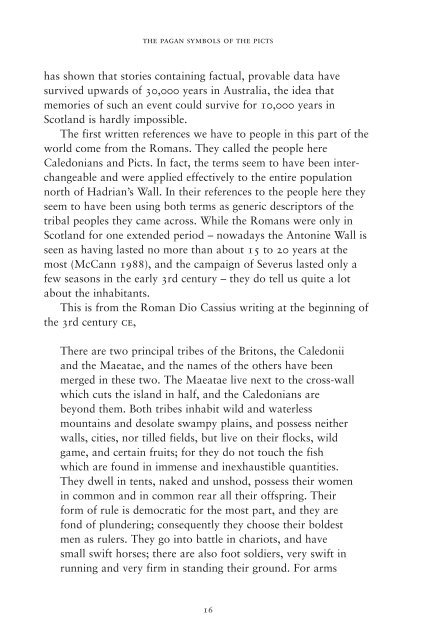Pagan Symbols of the Picts by Stuart McHardy sampler
Stuart McHardy examines the Pictish symbols which have been discovered on various items across Scotland. The book sets out a cohesive interpretation of the Pictish past, using a variety of both temporal and geographical sources. This interpretation serves as a backdrop for his analysis of the symbols themselves, providing a context for his suggestion that there was an underlying series of ideas and beliefs behind the creation of the symbols.
Stuart McHardy examines the Pictish symbols which have been discovered on various items across Scotland. The book sets out a cohesive interpretation of the Pictish past, using a variety of both temporal and geographical sources. This interpretation serves as a backdrop for his analysis of the symbols themselves, providing a context for his suggestion that there was an underlying series of ideas and beliefs behind the creation of the symbols.
Create successful ePaper yourself
Turn your PDF publications into a flip-book with our unique Google optimized e-Paper software.
<strong>the</strong> pagan symbols <strong>of</strong> <strong>the</strong> picts<br />
has shown that stories containing factual, provable data have<br />
survived upwards <strong>of</strong> 30,000 years in Australia, <strong>the</strong> idea that<br />
memories <strong>of</strong> such an event could survive for 10,000 years in<br />
Scotland is hardly impossible.<br />
The first written references we have to people in this part <strong>of</strong> <strong>the</strong><br />
world come from <strong>the</strong> Romans. They called <strong>the</strong> people here<br />
Caledonians and <strong>Picts</strong>. In fact, <strong>the</strong> terms seem to have been inter -<br />
changeable and were applied effectively to <strong>the</strong> entire population<br />
north <strong>of</strong> Hadrian’s Wall. In <strong>the</strong>ir references to <strong>the</strong> people here <strong>the</strong>y<br />
seem to have been using both terms as generic descriptors <strong>of</strong> <strong>the</strong><br />
tribal peoples <strong>the</strong>y came across. While <strong>the</strong> Romans were only in<br />
Scotland for one extended period – nowadays <strong>the</strong> Antonine Wall is<br />
seen as having lasted no more than about 15 to 20 years at <strong>the</strong><br />
most (McCann 1988), and <strong>the</strong> campaign <strong>of</strong> Severus lasted only a<br />
few seasons in <strong>the</strong> early 3rd century – <strong>the</strong>y do tell us quite a lot<br />
about <strong>the</strong> inhabitants.<br />
This is from <strong>the</strong> Roman Dio Cassius writing at <strong>the</strong> beginning <strong>of</strong><br />
<strong>the</strong> 3rd century ce,<br />
There are two principal tribes <strong>of</strong> <strong>the</strong> Britons, <strong>the</strong> Caledonii<br />
and <strong>the</strong> Maeatae, and <strong>the</strong> names <strong>of</strong> <strong>the</strong> o<strong>the</strong>rs have been<br />
merged in <strong>the</strong>se two. The Maeatae live next to <strong>the</strong> cross-wall<br />
which cuts <strong>the</strong> island in half, and <strong>the</strong> Caledonians are<br />
beyond <strong>the</strong>m. Both tribes inhabit wild and waterless<br />
mountains and desolate swampy plains, and possess nei<strong>the</strong>r<br />
walls, cities, nor tilled fields, but live on <strong>the</strong>ir flocks, wild<br />
game, and certain fruits; for <strong>the</strong>y do not touch <strong>the</strong> fish<br />
which are found in immense and inexhaustible quantities.<br />
They dwell in tents, naked and unshod, possess <strong>the</strong>ir women<br />
in common and in common rear all <strong>the</strong>ir <strong>of</strong>fspring. Their<br />
form <strong>of</strong> rule is democratic for <strong>the</strong> most part, and <strong>the</strong>y are<br />
fond <strong>of</strong> plundering; consequently <strong>the</strong>y choose <strong>the</strong>ir boldest<br />
men as rulers. They go into battle in chariots, and have<br />
small swift horses; <strong>the</strong>re are also foot soldiers, very swift in<br />
running and very firm in standing <strong>the</strong>ir ground. For arms<br />
16


















